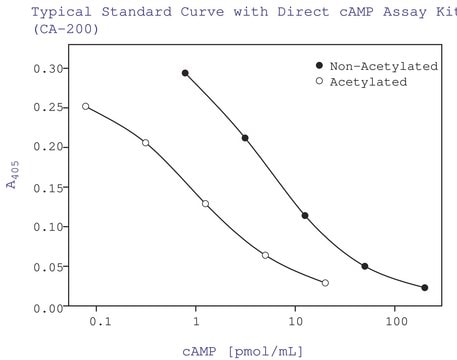CG200
cGMP Enzyme Immunoassay Kit, Direct
sufficient for 96 assays
About This Item
Polecane produkty
zastosowanie
sufficient for 96 assays
Poziom jakości
metody
ELISA: suitable
Warunki transportu
wet ice
temp. przechowywania
−20°C
informacje o genach
human ... PRKG1(5592) , PRKG2(5593)
Zastosowanie
Tylko elementy zestawu
- 0.1 M Hydrochloride Acid 1 x 30
- Acetic Anhydride 1 x 1
- cGMP-Alkaline Phosphatase Conjugate 1 x 5
- cGMP EIA Antibody Rabbit Anti-cGMP 1 x 5
- Cyclic GMP Standard 1 x 0.5
- Goat Anti-Rabbit IgG Coated 96 Well Microtiter Plate 1 ea
- Neutralizing Reagent 1 x 6
- p-Nitrophenyl Phosphate Substrate Solution 1 x 20
- Plate Sealer 1 ea
- Stop Solution 1 x 5
- Triethylamine 1 x 2
- Wash Buffer Concentrate 1 x 30
Hasło ostrzegawcze
Danger
Zwroty wskazujące rodzaj zagrożenia
Zwroty wskazujące środki ostrożności
Klasyfikacja zagrożeń
Acute Tox. 2 Inhalation - Acute Tox. 3 Dermal - Acute Tox. 4 Oral - Eye Dam. 1 - Flam. Liq. 3 - Met. Corr. 1 - Skin Corr. 1A - STOT SE 3
Organy docelowe
Respiratory system
Zagrożenia dodatkowe
Kod klasy składowania
3 - Flammable liquids
Temperatura zapłonu (°F)
120.2 °F
Temperatura zapłonu (°C)
49 °C
Certyfikaty analizy (CoA)
Poszukaj Certyfikaty analizy (CoA), wpisując numer partii/serii produktów. Numery serii i partii można znaleźć na etykiecie produktu po słowach „seria” lub „partia”.
Masz już ten produkt?
Dokumenty związane z niedawno zakupionymi produktami zostały zamieszczone w Bibliotece dokumentów.
Nasz zespół naukowców ma doświadczenie we wszystkich obszarach badań, w tym w naukach przyrodniczych, materiałoznawstwie, syntezie chemicznej, chromatografii, analityce i wielu innych dziedzinach.
Skontaktuj się z zespołem ds. pomocy technicznej











